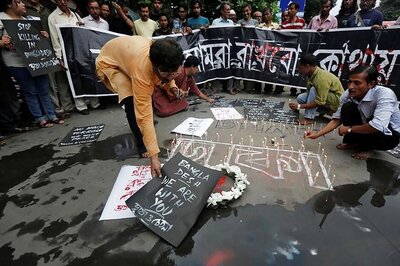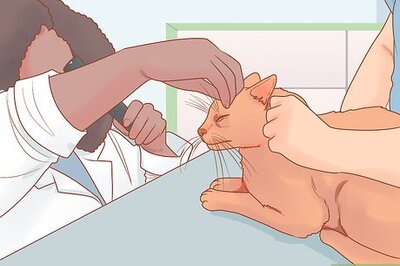
views
Viry-Chatillon, France: When Sebastian Vettel clinched his first drivers' championship last year, it brought as much cheer to a group of engineers in a suburb in Paris as it did to the German driver and his Red Bull colleagues. For, the heart of the championship winning Red Bull car, the engine, was developed at the Renault Sport F1 facility in Viry Chatillon, 25 km from Paris. IBNlive.com was provided exclusive access to this state-of-the-art facility and a chance to interact with engineers and designers, Formula One's unsung heroes whose role is pivotal to a team's success.
Renault is one of the most successful names in the history of Formula 1 having won multiple constructors’ and drivers’ titles. A visitor is introduced to this glorious history in the form of a display of winning engines from the past. Also displayed are framed pictures of every driver who won a race with Renault power. The drivers are the who's who of Formula One... Ayrton Senna, Michael Schumacher, Alain Prost, Fernando Alonso, Nigel Mansell, Jacques Villeneuve, Damon Hill, Jenson Button, Sebastian Vettel, Mark Webber and many more. Some of them have literally left their mark in the facility with their autographs on a board.
Renault has been in the sport both as an engine supplier and a constructor. As a constructor, it won the championship in 2005 and 2006 with Fernando Alonso at the wheel. Since last year, Renault pulled out as a constructor and is now solely focussed on supplying engines.
Last year, Renault was an engine supplier to two teams – Red Bull Racing and Lotus Renault GP. This season there has been the addition of Team Lotus to the existing teams. In 2012, Williams will become its 4th customer. The high-performance engines are designed and built (prototypes) at this facility, which employs 250 people.
Philip Régior, head of Cylinder Head and Turbocharger group, explained the functioning of the engine design department. “There are five departments in the engineering design section. The main mission of the engineering division is to define and detail the specifications of the engine components considering the durability, performance, weight, centre of gravity and cost. Once the specs are established, we begin the design of parts using several software programmes in order to produce virtual representation of the parts within the engine. We use the CAD system in order to have a complete digital mock-up of the engine. During the design phase, the designer and engineer in charge of the concerned parts work closely along with the simulation department in order to check that the design fulfils the requirement of the parts in different fields like mechanical, thermal etc. The designer works closely with the supplier in order to see if the design is feasible or not.”
Régior said that compared to designing engines for road cars, the requirements for Formula One cars are quite different.
“The requirements are not the same, especially on performance, weight saving and drivers. We use the same tools but with different constraints.” Speaking about the design department’s role after the season begins, Régior said that their focus is on engine reliability. A Formula One engine is very demanding with all the components. There are several small issues that we have to control. We are always working on new design to solve those issues and eradicate any problems.”
Speaking about the changes in engine specifications for 2014, he said: There will be new technology from 2014 like direct injection, turbocharger, electric power-assisted engine. These fields are completely new for us. We have to adapt our staff to this new technology in order to have the knowledge available in house. The electrical development is a very big challenge for us. A dedicated team has been set up this year.” He added that the rule changes from 2014 provided an opportunity to develop new components and new technology that were not allowed as per the previous regulations".
The dynamometer or dyno department plays a critical role in engine reliability and mapping because of in-season testing ban. Cedrik Staudohar, a dyno test engineer, explains: In the previous seasons when track testing was allowed, if we had some problems, we could investigate it on the track. However, now we have to anticipate the problems at the factory and find solutions. It’s very important to have a facility like this to ensure that we have the right mappings on Grand Prix weekends.”
Engines are run for thousands of kilometers on the dyno to test their reliability and mapping systems. “We also do some mapping tests to ensure that the engine responds to the driver’s needs. For example, when the driver is demanding torque we verify in the dyno whether the engine is responding well or not. If there are problems on the track we try to reproduce and solve those problems on dyno and find some different mappings to ensure the problem doesn’t appear again,” he said.
Since most of the engine systems are controlled electronically, the electronics department plays an important role in the design stage as well as during racing weekends. Antoine Lenain, head of integration and validation group, says: Electronics drives the engine. Ignition and fuel injection is controlled electronically. The advantage of electronics is that we can set up the injection and ignition depending on conditions like weather, circuit, drivers demands etc. Our role is to test all the electronics systems.”
Lenain said that the Friday practice sessions, which seem inconsequential for fans, are important for them. “It’s more important now than before. We can get all the data from the car and replay it on the simulator.” The simulator can reproduce the dynamic behaviour of the engine, gearbox strategy and the driver for every circuit.
“We can test new calibration and compare it with previous calibration and behaviour. It’s less expensive and more simple than run this data directly on the dyno. If people on the rack have some problem on Friday, we can try here (on the simulator) with the same package and try to find a solution,” he said.




















Comments
0 comment